#deodar forests
Text
Discover Jana Village - A Hidden Gem in Kullu, Himachal Pradesh | Mysterious Himachal
Introduction
Nestled amidst the lush green valleys and snow-capped mountains of Himachal Pradesh, Jana Village is a hidden gem waiting to be discovered. This picturesque village, located in the Kullu district, offers an unparalleled experience for those seeking solace and tranquillity in the lap of nature. In this comprehensive guide, we at Mysterious Himachal will take you through the…
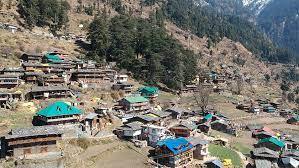
View On WordPress
#Apple Orchards#Bijli Mahadev Temple#deodar forests#Himachal Pradesh#jana#jana village#jana waterfall#Kullu valley#Naggar Castle
0 notes
Text

Present.
India 2023.
#travel#photography#india#backpacking#nature#mountains#himalayas#trees#fields#home#belonging#land#wheat#rice#landscape#relaxing#solitude#deodar#pine#forests#life#contemplate#consider
3 notes
·
View notes
Text
Planting trees does not necessarily mean a forest is being restored.
---
But efforts to increase global tree cover to limit climate change have skewed towards erecting plantations of fast-growing trees. The reasons are obvious: planting trees can demonstrate results a lot quicker than natural forest restoration. This is helpful if the objective is generating a lot of timber quickly or certifying carbon credits which people and firms buy to supposedly offset their emissions. [...] [I]ll-advised tree planting can unleash invasive species [...]. For more than 200 years India has experimented with tree plantations, offering important lessons about the consequences different approaches to restoring forests have on local communities and the wider environment. This rare long-term perspective should be heeded [...].
Britain extended its influence over India and controlled much of its affairs [...] from the mid-18th century onwards. Between 1857 and 1947, the Crown ruled the country directly and turned its attention to the country’s forests. Britain needed great quantities of timber to lay railway sleepers and build ships in order to transport the cotton, rubber and tea it took from India.
Through the Indian Forest Act of 1865, forests with high-yielding timber trees such as teak, sal and deodar became state property. To maximise how much timber these forests yielded, British colonial authorities restricted the rights of local people to harvest much beyond grass and bamboo. [...] Meanwhile plantations of teak (Tectona grandis), a species well adapted to India’s hot and humid climate and a source of durable and attractive timber, spread aggressively. [...]
---
[G]rasslands and open scrub forest gave way to teak monocultures.
Eucalyptus and other exotic trees which hadn’t evolved in India were introduced from around 1790. British foresters planted pines from Europe and North America in extensive plantations in the Himalayan region as a source of resin and introduced acacia trees from Australia for timber, fodder and fuel.
One of these species, wattle (Acacia mearnsii), first introduced in 1861 with a few hundred thousand saplings, was planted in the Nilgiris district of the Western Ghats. This area is what scientists all a biodiversity hotspot – a globally rare ecosystem replete with species. Wattle has since become invasive and taken over much of the region’s mountainous grasslands.
Similarly, pine has spread over much of the Himalayas and displaced native oak trees while teak has replaced sal, a native hardwood, in central India. Both oak and sal are valued for fuel, fodder, fertiliser, medicine and oil. Their loss [...] impoverished many.
---
India’s national forest policy [...] aims for trees on 33% of the country’s area. Schemes under this policy include plantations consisting of a single species such as eucalyptus or bamboo which grow fast and can increase tree cover quickly, demonstrating success according to this dubious measure. Sometimes these trees are planted in grasslands and other ecosystems where tree cover is naturally low. The result is that afforestation harms rural and indigenous people who depend on these ecosystems [...].
In the Kachchh grasslands of western India communities were able to restore grasslands by removing the invasive gando bawal (meaning “mad tree”) first introduced by British foresters in the late 19th century. [...]
The success of forest restoration efforts cannot be measured by tree cover alone. The Indian government’s definition of “forest” still encompasses plantations of a single tree species, orchards and even bamboo, which actually belongs to the grass family. This means that biennial forest surveys cannot quantify how much natural forest has been restored, or convey the consequences of displacing native trees with competitive plantation species or identify if these exotic trees have invaded natural grasslands which have then been falsely recorded as restored forests. [...]
Planting trees does not necessarily mean a forest is being restored. And reviving ecosystems in which trees are scarce is important too.
---
Text by: Dhanapal Govindarajulu. "India was a tree planting laboratory for 200 years - here are the results." The Conversation. 10 August 2023. [Bold emphasis, some paragraph breaks/contractions, and italicized first line in this post added by me.]
141 notes
·
View notes
Text
HIDIMBI DEVI TEMPLE

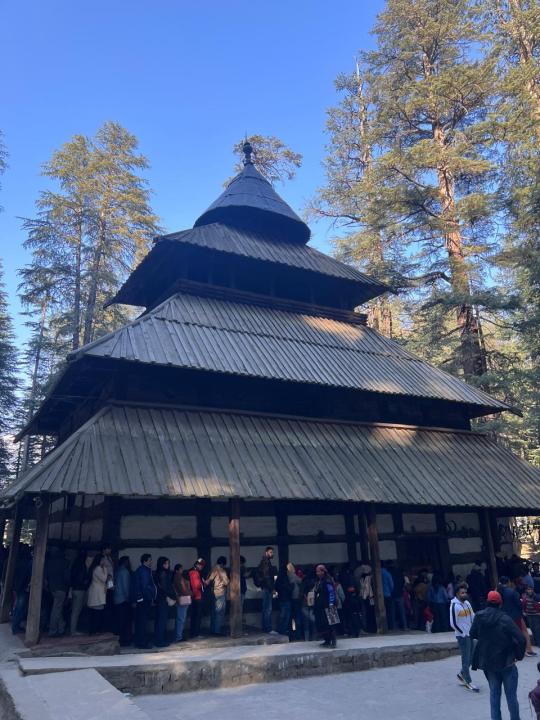
Manali, a popular destination in Himachal Pradesh, is home to the Hidimbi Devi Temple, also known as the Hadimba Temple. Situated in Manali village, around two kilometres from the town, this temple is famous for the Phaghi fair held in honour of Manu Maharaj on the sixth day of Phalgun.
The temple, an ancient cave dedicated to Hidimbi Devi, is surrounded by lush greenery and Deodar trees, creating a serene atmosphere. Legend has it that during the Pandavas' exile, Bhima, one of the brothers, fell in love with Hidimbi, the sister of the local ruler, Hadimb. Bhima defeated Hadimb, married Hidimbi, and they had a son named Ghatotkacha. When the Pandavas returned from exile, Hidimbi stayed behind to meditate and eventually became a goddess, with the cave as her sacred abode.
The temple, known as Dhoongri temple due to its location in the Dhungiri Van Vihar forest, is a beautiful wooden structure with thatched roofs. While it's only 1.5 kilometres from the town, visiting early in the morning is advisable, especially during the busy summer season when Manali is often congested with traffic.
📍 LOCATION:Regency Road, Siyal Rd, Siyal, Manali, Himachal Pradesh
19 notes
·
View notes
Note
i love clanmew so much I wanted to translate my oc's name
their name is Cedarshine and they're a disabled med cat (in the books its a trope i'm not fond of but as a real life disabled person i thought it would be interesting to explore my own feelings through a Cat)
the closest direct translation would i think be Fiffshem but Fiffshayu is closer to why I chose the -shine prefix, the idea of a medicine cat who wants to impart happiness as well as healthiness
Cedars!

[ID: A deodar cedar. Photo sourced from treesplanet.com]
Cedar is a very interesting species. It's a conifer not native to England; but extremely valuable for its unique properties. It's mostly planted in parks for its striking appearance, and seen mostly near humans. Snapping off branches, rendering them into chips, and using them as bedding was the best insect repellant they had before the discovery of salt.
In the Lake territories, there is no cedar. Clan cats have to go into human settlements to find it. Back in the forest, there were a few clumps of it near twolegplace in ShadowClan territory and a couple planted by human farms.
It's still remembered fondly though, and carried on in prefix names. Sort of like how "Dolores" is Latin for sorrow, but most people only name their kids Dolores because they're honoring a relative.
It's interesting that cedar is kind of like "ancient wood salt" to clan cats, in a way. The name probably has a bit of an old, traditional healer vibe, which I think fits your OC super nicely.
There are two types of cedar seen in this region, the deodar cedar (Cedrus deodara) and the atlas cedar (Cedrus atlantica), but Clan cats don't encounter them enough to have different words. So there is one word;
Cedar = Shawogi
Holy + Kill + Bug, massively contracted over time.
So Shawogishayu or Shawogishem, if you'd like to update your OC's name!
37 notes
·
View notes
Text
Pabbar Valley Tourist Spot in Shimla, Himachal Pradesh
Pabbar Valley, nestled 80 kilometers from Shimla, is a serene and picturesque destination in Himachal Pradesh. This charming valley is surrounded by towering mountains and lush green meadows, offering stunning views that leave visitors in awe. Known for its dense oak and deodar forests, scenic apple orchards, and the peaceful Pabbar River, the valley is a paradise for nature lovers and adventure enthusiasts. If you’re looking for offbeat places near Pabbar Valley that promise tranquility and natural beauty, you’ll find this destination to be a perfect escape from the hustle and bustle.

When exploring places to visit near Pabbar Valley, you should definitely consider visiting the nearby Chanshal Pass. This high-altitude pass offers breathtaking panoramic views of the snow-capped peaks and verdant valleys below. It’s an excellent spot for photography and enjoying the crisp mountain air. Another must-see is the quaint village of Kotkhai, known for its traditional architecture and serene surroundings. Here, you can immerse yourself in local culture and enjoy a peaceful stroll through apple orchards and terraced fields.
Additionally, the beautiful town of Rohru, located not far from Pabbar Valley, is worth a visit. Rohru is famous for its apple orchards and the scenic Pabbar River, which is perfect for fishing and nature walks. The town also offers opportunities for outdoor activities like trekking and camping. Exploring these places to visit near Pabbar Valley provides a wonderful mix of natural beauty, adventure, and local charm, making it an ideal choice for travelers seeking a memorable getaway.
#Pabbar Valley#places to visit near Pabbar Valley#Pabbar Valley tourism#Pabbar Valley travel guide#Himachal Pradesh#india#india travel#india tourism#incredible india#Shimla#indian#travel#travel photography#Shimla tourism#ncuti gatwa#needlework#neil gaiman#newjeans#niall horan
2 notes
·
View notes
Text
Located in the picturesque state of Himachal Pradesh, Kufri is a charming hill station just a short drive away from Shimla. Known for its serene landscapes and pleasant climate, Kufri is a perfect destination for travelers seeking tranquility amidst nature. Offbeat places in Kufri offer a unique glimpse into the lesser-explored corners of this popular tourist spot. Away from the bustling crowds, these hidden gems promise an enriching experience for those willing to wander off the beaten path.

One such hidden gem is Green Valley, a serene natural wonder tucked away off the Shimla-Kufri road. Surrounded by majestic mountains, this valley is adorned with dense pine and deodar forests, creating a stunning backdrop for nature enthusiasts and photographers alike. Here, you can witness yaks grazing peacefully, adding to the valley's rustic charm. Green Valley in Kufri offers a tranquil escape from the usual tourist spots, making it an ideal retreat for those looking to unwind and reconnect with nature.

Another offbeat attraction worth exploring in Kufri is Mahasu Peak, one of the highest points in the region. Offering breathtaking views of the Kedarnath and Badrinath ranges, Mahasu Peak is a paradise for adventure seekers and nature lovers alike. The journey to the peak is an adventure in itself, whether you opt for a mule ride through dense forests or prefer a scenic hike amidst towering deodars. At the summit, you'll discover the serene Nag Temple and Mahasu Ridge, perfect for skiing enthusiasts looking to hone their skills before tackling more challenging slopes. Mahasu Peak in Kufri is a must-visit for those craving both adventure and tranquility in the lap of the Himalayas.
For travelers yearning to explore beyond the usual tourist circuit, Kufri offbeat places offer a delightful escape into untouched natural beauty and serene landscapes. Whether you choose to wander through Green Valley's lush forests or conquer Mahasu Peak's heights, Kufri promises an unforgettable journey off the beaten path. Discover these hidden treasures and immerse yourself in the serene charm of Kufri's lesser-known wonders.
#clearholidays#kufri#kufri tourism#places to visit in shimla#offbeat places#offbeat tourism#himachal pradesh#himachaltourism#india#indian#travel#india travel#india tourism#incredible india#kufri offbeat places#offbeat places in kufri
2 notes
·
View notes
Text
Chopta, nestled amidst the majestic Garhwal Himalayas in Uttarakhand, India, is a hidden gem for travelers seeking tranquility and natural beauty off the beaten path. Known for its serene landscapes and spiritual sanctuaries, Chopta offers a unique blend of pilgrimage sites and pristine wilderness. This picturesque destination becomes particularly enchanting during winter when the Tungnath temple, surrounded by the quaint Makkumath Village, is blanketed in thick snow, creating a serene haven amidst nature's splendor. Beyond its religious significance, Makkumath Village provides a peaceful retreat, nestled amid lush green mountains adorned with oak, rhododendron, and deodar forests, offering visitors a tranquil environment filled with greenery and tranquility.

One of the lesser-explored offbeat places in Chopta is Baniyakund Village, a small and tranquil settlement located in the breathtaking Chopta region. Situated at an elevation of 2450 meters, Baniyakund Village serves as the gateway to the Chopta-Tungnath trek, renowned as one of Uttarakhand's most popular treks. This village is cherished for its lush green surroundings and spectacular mountain vistas, making it a beloved destination for nature enthusiasts and hikers alike. Away from the hustle and bustle of city life, Baniyakund Village offers a serene escape amidst the Garhwal Himalayas, providing a perfect setting for rejuvenation and exploration.

Exploring Chopta offbeat places like Makkumath and Baniyakund Villages allows travelers to delve deeper into the natural beauty and cultural heritage of Rudraprayag district. These hidden gems offer not only stunning landscapes and spiritual retreats but also opportunities for adventure and introspection amidst the tranquil ambiance of the Garhwal Himalayas. Whether you're drawn to pilgrimage sites, hiking trails, or simply seeking moments of serenity in nature, Chopta promises a memorable journey off the beaten path in Incredible India.
#clearholidays#chopta#chopta tourism#places to visit in rudraprayag#offbeat places#offbeat tourism#uttarakhand#india#indian#travel#india travel#india tourism#incredible india#chopta offbeat places#offbeat places in chopta
2 notes
·
View notes
Text



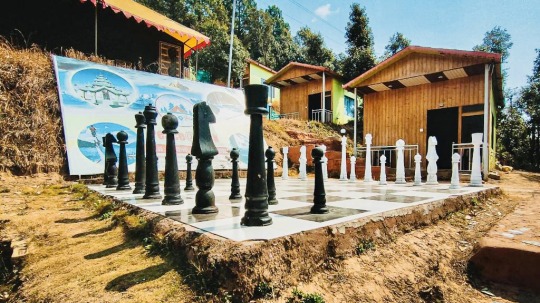








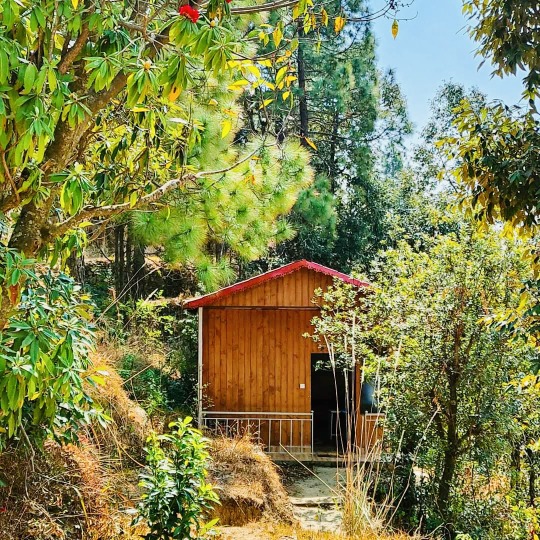
Best Resort Kanatal uttarakhand near dhanaulti
CALL US FOR BOOKING 9891532947
#KANATALCROWN #RESORTINKANATAL #DHANAULTI #UTTARAKHAND #TRIPTOKANATAL
ABOUT KANATAL
Hotel Kanatal Crown, a nature resort that is a precious jewel in the crown of Uttarakhand gives you a remarkable, alluring and bracing holiday experience. Set amidst majestic forests of pine, deodar trees, magnificent rhododendrons, fruit-bearing apple trees, terrace farms intricately carved along hillsides, Water Fall chirping birds all around and the fresh, invigorating mountain air, the impeccable lodging, travel, Wellness, adventure, conference, dining, and entertainment facilities at Hotel Kanatal Crown blend beautifully with nature's bounty.
Hotel Kanatal Crown is framed in a five acre plot with a view of snow-clad Himalayan peaks. Hotel Chakrata Homes offers 10 rooms and a suite with the excellent facilities which have been designed with careful thought to the most minute details and painstaking efforts, all aimed at enhancing the comfort and well being of our esteemed guests.
Hotel Kanatal Crown is one of Delhi’s nearest snow destination, occupying prime location on the Mussoorie Chamba highway, the high point of the year at Dhanaulti occurs between December and February, when over 50 inches of powder snow carpets its areas, creating a spectacular Cottonwood Canyon and transforms the landscape into a ravishing white wonderland. It’s a paradise where you can put your feet up, pamper your frayed nerves and take in deep breaths of the Frangipani-scented breeze that wafts across the resort. Best Resort In Kanatal, Hotels in Kanatal Crown
#uttarakhand#india#pahadi#uttarakhandheaven#travel#dehradun#himalayas#nature#uttarakhandtourism#mountains#incredibleindia#photography#rishikesh#travelphotography#himachal#uttrakhand#uttarakhanddiaries#kedarnath#uttarakhandtraveller#devbhoomi#instagram#nainital#love#garhwal#almora#uttarakhandi#diaries#travelgram#delhi#pithoragarh
4 notes
·
View notes
Text

@abyssmalice ➤ unprompted
(a story for the god of hugs? very well, tol toni will do her best - !)
“Let’s see.” She hums, her one eye closing in thought for a moment. “How about... yes. Shall I tell you the story of the king and the deodar god? Once upon a time, in an era that was and wasn’t, there was a king who lived in a land of great verdure and wisdom.
“One day, this king wished to repair his palace. However, rather than mere maintenance, he resolved to rebuild it better and grander. Thus, he ordered his advisors to seek a type of tree that would satisfy his great requirements. These advisors searched high and low, scattering themselves across the distant boundaries of the land, and brought many a kind of tree to the king’s attention.
“However, despite this, despite the vast forests and splendid greenery surrounding his kingdom to the horizon and beyond - the king could not be satisfied. Not until one maidservant, from a distant village, made mention of a great tree that her hometown worshipped.
‘”It is a tree that has stood tall and beautiful for generations upon generations,’ so said the maidservant in passing, ‘thus do we worship it, for no doubt, it bears the wisdom of a god within it.’
“Piqued by this, the king thus set forth to the servant’s village. There, he beheld a most magnificent tree - a deodar of great age, standing far above even the tallest house in the village. Its branches numbered in the thousands, and upon the boughs, its dark pines stretched out into a gentle canopy. The king was enthralled by such a wonderful tree. And so, he demanded to have it cut down for his palace.
“The villagers protested, of course. For it was an ancient tree, their divine protector and patron - how could they allow it to be cut down? The king could argue his point as much as he wished, but they would not acquiesce to such an order, even from their sovereign.
“This continued for many a day, with a simmering bitterness as negotiations continued to fail. After one such failure, the frustrated king retired for the day, deciding he shall ruminate on his options and find another way to persuade them. It was that night, as he dreamt, that the divinity of the deodar spoke to him -
‘”O’ ye lord, child of man and knowledge. I do not berate your ambition, for humanity is fated to surpass the gods themselves. However, know this - an ambition is a spark to a fire, and all fires require timber. O’ ye lord, child of man and knowledge but not wisdom—do you wish for your home and all within to burn?’
“Awakening from this dream, the king was certainly frightened. And yet, as he allowed the god’s words to settle, he was humbled by the wise words of the divine tree. Thus, he returned to the village and declared that he would no longer seek the wood of the divine deodar, apologizing for wasting his people’s time in such a frivolous manner.
“He returned to the capitol, and decided instead to rebuild his palace with stone instead of wood, refocusing on his duties as a wise king.” Tonia claps her hand. “And his reign was considered a golden age for that era. The end.”

Eyebrows raised a little as Tonia began recalling a story that they had so explicitly asked for, chin coming to rest in their palm and eyes half-lidded as they so quietly listened without a peep or chime.
They’d be lying if they didn’t say that something resonated deep within them ... memories of the past, of verdant forests, of people who thought themselves above the eyes of the gods ... people had very much tried the same with the hybrid Irminsul that one decorated the Sumerian lands. For research, for some superstition, for its properties ... those humble would receive, those with an ambition to spark a flame, well ... a 13-foot talking deer does often dissuade most people from going through with that blaze.
It took them a little while before they spoke again, starting off with a low rumble and settling into a fond sigh. “I almost feel like this was targeted to me ... a wise deity in a tree? Having to keep outside humans away from taking too much? ... hopefully he didn’t come across a talking stone as well that was worshipped.”

Terrible joke, but they couldn’t help but to heartily cackle for a moment—hard not to when being a creature of the elements and knowing that everything could have a life tied to it. Their laughter eventually died down into another content sigh, straightening up from their rested position.
“... a good story to be passed down, that is for sure. Perhaps I will tuck that into my memory as a little story to share with others as well, even if only by mouth.” Even if it was never to exist in written word ... even one person recalling it will bring it back to life, once more.
#[ sylvie vc: i came out to have a good time and i did but also was attacked ]#SYLVIE // ANSWERED.#OOC // WAITING FOR QUEUE.#abyssmalice
3 notes
·
View notes
Text
Jana Waterfalls | Manali Himachal Pradesh
Jana Waterfalls | Manali Himachal Pradesh
One of the most alluring destinations in the picturesque community known as Jana is a waterfall known as Jana Waterfall. In the Himalayan region of Manali, you’ll find this settlement just a few kilometres away from Naggar. The breathtaking natural splendour of this waterfall allows each traveller to experience it in a way that they never had before.
The water cascades down from a certain…

View On WordPress
#Apple Orchards#deodar trees#jana village#jana waterfall#kullu#Manali#naggar village#pine forests#snow-capped mountains
0 notes
Text
Best Manali-Kasol Tour Package
If you're looking for a getaway that combines adventure and relaxation in the Himalayas, the Best Manali-Kasol Tour Package from Thrillonhills Travel Agency is your perfect choice. This package brings together the best of Manali, a bustling hill station known for its scenic beauty and adventure sports, with the peaceful charm of Kasol, a small village famous for its laid-back vibe. Whether you're an adventure lover or simply looking to unwind, this tour offers a memorable experience in the lap of nature.

Why Choose a Manali-Kasol Tour Package?
Manali and Kasol are two of the most popular destinations in Himachal Pradesh. Manali offers a wide range of activities, from thrilling adventure sports to sightseeing, while Kasol is ideal for those seeking serenity and a slower pace of life. Together, they make the perfect combination for a well-rounded mountain getaway.
Key Highlights of the Manali-Kasol Tour Package
Our Manali-Kasol Tour Package takes you through the best of both destinations, ensuring you experience the adventure, beauty, and calmness that these places are known for.
1. Manali – The Adventure Hub
Your journey begins in Manali, a beautiful town surrounded by towering peaks, lush valleys, and flowing rivers. Manali is perfect for adventure enthusiasts, nature lovers, and those seeking cultural experiences.
Solang Valley: A hotspot for adventure, Solang Valley offers paragliding, zorbing, and skiing (during winter), making it an ideal place for thrill-seekers.
Rohtang Pass: A must-visit, this high-altitude pass offers panoramic views of the snow-capped mountains and is perfect for snow activities during the colder months.
Hadimba Temple: Set amidst a deodar forest, this ancient temple is a peaceful stop that provides a glimpse of the region’s rich cultural heritage.
Old Manali: Known for its bohemian vibe and charming cafes, Old Manali is great for exploring, shopping, and enjoying the local food.
2. Kasol – The Serene Escape
After experiencing the energy and adventure of Manali, the tour takes you to Kasol, a quiet village known for its scenic beauty and relaxed atmosphere. It’s the perfect place to unwind and enjoy the beauty of nature.
Tosh Village: For those looking to explore more, the Tosh trek offers stunning views of the surrounding mountains and a peaceful retreat in the hills.
Café Culture: Kasol is home to many cafes that offer a mix of cuisines, allowing you to sit back, relax, and enjoy a good meal while soaking in the views of the surrounding hills.
Manikaran Sahib: A short drive from Kasol, this famous Sikh shrine is known for its hot springs and spiritual significance, adding a cultural touch to your trip.
Why Book with Thrillonhills Travel Agency?
At Thrillonhills Travel Agency, we are committed to providing you with an exceptional travel experience. Here’s why our Manali-Kasol Tour Package stands out:
Customizable Itinerary: Our tour packages are customizable, allowing you to choose the activities that suit your interests, whether it’s adventure, nature, or relaxation.
Comfortable Stays: Enjoy your stay in cozy and well-equipped hotels in Manali and Kasol, ensuring that your nights are as enjoyable as your days of exploration.
Expert Guides: Our knowledgeable guides will ensure you get the most out of your trip, offering insights into the local culture, history, and hidden gems.
Hassle-free Travel: From your pickup in Delhi to your journey through Manali and Kasol, we ensure that your travel is smooth and stress-free, allowing you to focus on enjoying your vacation.
Best Time to Visit Manali and Kasol
The best time to visit depends on the experience you’re seeking:
Summer (March to June): This is the ideal time for outdoor activities like trekking, sightseeing, and enjoying the pleasant weather.
Monsoon (July to September): The region becomes lush and green during this time, though outdoor activities may be limited due to rain.
Winter (October to February): If you’re a fan of snow, winter is the perfect time to visit Manali. The town is covered in snow, offering opportunities for skiing and other winter sports.
Conclusion
The Manali-Kasol Tour Package from Thrillonhills Travel Agency offers the best of both worlds—adventure and serenity. With thrilling activities in Manali and peaceful moments in Kasol, this tour provides the perfect escape for all kinds of travelers. Whether you want to explore the rugged landscapes of Manali or relax in the calm atmosphere of Kasol, this tour promises an unforgettable Himalayan experience.
Book your Manali-Kasol Tour Package today and let Thrillonhills Travel Agency take you on a journey through the majestic Himalayas!
0 notes
Text
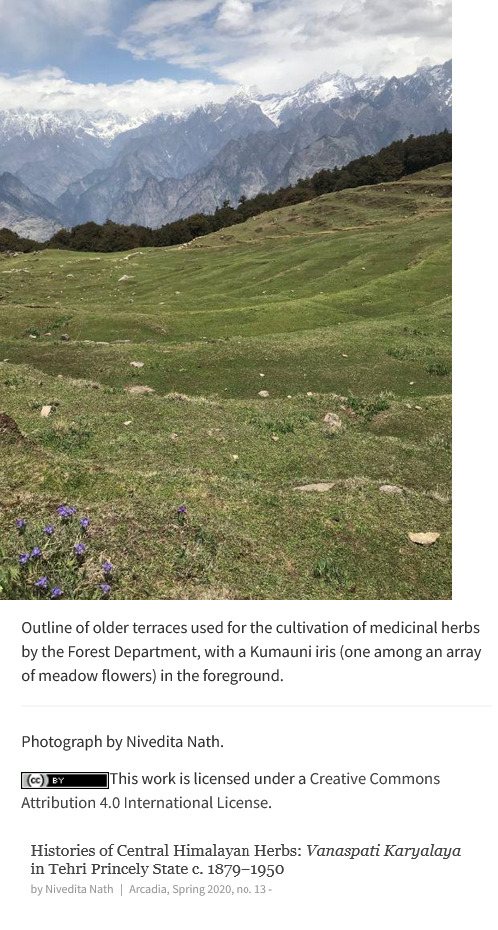
In the district of Garhwal in the Indian Himalayas, at 10,000 feet (3,048 meters) above sea level, forests of sycamore, chestnut, and rhododendron gradually give way to gently sloping grasslands.
Known locally as bugyals (from the Garhwali word bug for soft grasses), these meadows were the favored grazing grounds of communities of trans-Himalayan traders [...]. High-altitude meadows are home to musk deer, moonal pheasants, and a variety of flowers, grasses (such as the scented jambu), medicinal herbs, and roots (jadi butiyan). Garhwali villagers had long used the jadi butiyan of bugyals for household consumption and trade. Customary restrictions [...] made this usage sustainable.
The advent of [...] [colonial and institutional] forestry in the princely state of Tehri-Garhwal (the Tehri Durbar), together with the growth of an urban elite Hindu market for Ayurvedic potions, arguably transformed the social lives of Himalayan herbs. [...]
---
Works by upper-caste elites, such as the Maharaja of Gondal’s Aryan Medical Science (1895), claimed an exclusively “Hindu” provenance for the medicinal practices of Ayurveda. The nationalist reinvention of modern Ayurveda generated a market for medicinal herbs dominated by over a dozen firms by 1910. This emergent urban [...] bourgeois market for herbal medicines provides the context for the Tehri Durbar’s arguably unique project to commodify Himalayan herbs. Whereas the British government was reluctant to expand the plantation and manufacture of indigenous drugs, the Durbar established a separate department for the purpose, called the Vanaspati Karyalaya, that worked closely with the Forest Department.
Subordinated to the British government, the Tehri Durbar had begun contracting out vast swathes of pine and deodar forests to timber traders from the mid-nineteenth century onwards. In 1879 the Durbar’s Forest Department [...] restricted peasant access to common resources. Restrictions on the sale and collection of forest produce were put in place between 1878 and 1885, [...] precipitating numerous forest dhandaks (uprisings) as a consequence. Rules governing forest access changed in response to such protests and by 1930 prohibitions on the collection of and trade in medicinal herbs were lifted in certain areas.
The foundation of the Vanaspati Karyalaya prompted the systematization of the Forest Department’s initial efforts to monetize the collection of herbs through taxes, contracts, and tenders. By 1927 the department was working with the Karyalaya to carry out the sale of medicinal herbs, such as Gugal, Mashi, Atis, and Kawri, yielding an income of 18,294 rupees. [...] From the Durbar’s Annual Reports, [...] the Karyalaya’s preparation of Ayurvedic medicines seemed to have commanded “ready sale” primarily in the domestic market. Subsequently, therefore, the Forest Department focused on the overall sale and plantation of herbs while the Karyalaya specialized in the processing of herbs.
---
Anticipating an extension of markets “as demand for Himalayan medicines grows,” the Durbar charted a project of mass plantation to overcome the “expense and difficulty of searching for herbs of indigenous growth” that were “scattered among other herb plants and weeds.”
The bugyals of Garhwal were thus classified as “wastelands” from which “practically no income at present can be derived.”
This justified plans for the cultivation of aconites such as kut and atis on a projected area of 2,000 square miles (517,997 hectares) of alpine grassland. In the 1930s, the Durbar initiated the plantation of kut in the Ganga Bhillangana Forest Division, employing trained gardeners as well as “coolie” labor to transplant herbs from nurseries to enclosed meadows. Thus, bugyals hitherto controlled by villagers [...] were gradually being enclosed for herb plantations. The Karyalaya also opened a pharmaceutical works just outside the town of Rishikesh at Muni ki Reti [...]. Graduates of [...] colleges in Delhi and Calcutta [...] were hired for these operations. [...] [T]he Tehri Durbar’s move towards the mass plantation and processing of herbs risked dispossessi[on] [...] as well as eliding local knowledges related to jadi butiyan.
The story of the Vanaspati Karyalaya arguably suggests how complex cultural associations between the Himalayas and healing were becoming commodified.
---
Image, caption, and all text above by: Nivedita Nath. "Histories of Central Himalayan Herbs: Vanaspati Karyalaya in Tehri Princely State c. 1879-1950". Environment & Society Portal, Arcadia (Spring 2020), no. 13. Rachel Carson Center for Environment and Society. doi dot org/10.52982/rcc/9018 [Bold emphasis and some paragraph breaks/contractions added by me. Presented here for commentary, teaching, criticism purposes.]
134 notes
·
View notes
Text
Tranquility in Aglar Valley: Devalsari
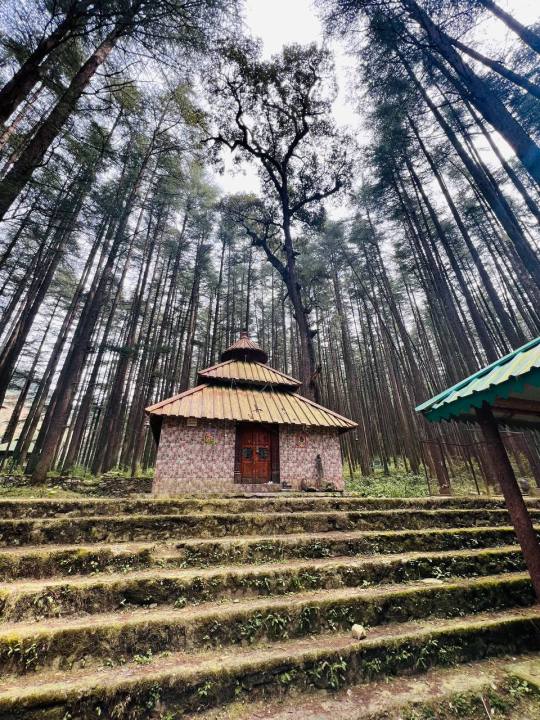
Devalsari Temple is an ancient temple dedicated to Lord Shiva, located in the Aglar Valley of Tehri Garhwal district, Uttarakhand, India. It is situated at an altitude of 1722 meters (5650 feet) above sea level, amidst dense deodar forests and lush green meadows. The temple is about 55 kilometers (34 miles) from Mussoorie and 80 kilometers (50 miles) from Dehradun.
The journey to Devalsari Temple is as enchanting as the destination itself, with winding roads offering breathtaking views of the surrounding hills. The temple's location amidst the tranquil surroundings makes it a perfect retreat for nature lovers and spiritual seekers alike.
The temple is believed to have been built in the 16th century by the Katyuri kings. The sanctum sanctorum of the temple houses a Shivling, which is said to be self-manifested. The temple is also home to a number of other deities, including Parvati, Ganesh, and Nandi.
Tourist Attraction
The Devalsari Temple Mussoorie is a popular pilgrimage site, especially for Hindus from the Garhwal region. The temple is also a popular tourist destination, known for its scenic beauty and tranquil atmosphere.
Best Time to Visit Devalsari Temple
The best time to visit the Devalsari Temple is between the months of April and June, when the weather is pleasant and the surrounding hills are lush green. The temple is open from 6:00 AM to 12:00 PM and again from 3:00 PM to 9:00 PM.
📍 LOCATION : Aglar Valley, Tehri Garhwal district, Uttarakhand, India.
9 notes
·
View notes
Text
Wildlife and Wonders: Discovering the Natural Splendor of Chopta

Nestled high in the Uttarakhand region of India, amidst a tapestry of lush green meadows and towering snow-capped peaks, lies a hidden gem waiting to be explored—Chopta. Often referred to as the "Mini Switzerland" of India, this pristine paradise offers breathtaking vistas and an incredible array of wildlife and natural wonders that will leave you spellbound. Whether you're an avid trekker seeking adventure or a nature enthusiast yearning for tranquility, Chopta invites you to step into its serene embrace. Join us as we embark on an enchanting journey through verdant forests and vibrant landscapes, uncovering the rich biodiversity and stunning allure that make this destination truly extraordinary. Get ready to explore trails less traveled and witness the magical wonders that await in this untouched slice of heaven!
Introduction to Chopta and its Magnificent Natural Beauty

Nestled amidst the majestic Himalayas, Chopta is a hidden gem waiting to be explored. With its lush green meadows, towering peaks, and mesmerizing landscapes, this quaint destination offers a slice of paradise for nature lovers and adventure seekers alike. Imagine waking up to the sound of chirping birds, surrounded by snow-capped mountains that stretch as far as your eyes can see. Each corner of Chopta reveals an enchanting vista that beckons you to explore further.
Chopta's unique charm lies not just in its natural beauty but also in its rich cultural heritage and spiritual significance. As you wander through this serene landscape, you'll discover ancient temples steeped in history and breathtaking trekking trails that challenge both body and mind. Whether you're seeking solace or adventure, Chopta promises an unforgettable experience—one that's sure to leave lasting memories etched in your heart.
Exploring the Famous Tungnath Temple

Tungnath Temple, perched at an elevation of 3,680 meters, is one of the highest Shiva temples in the world. Nestled in the majestic Himalayas, this ancient structure draws pilgrims and adventurers alike. The temple's history dates back thousands of years. It’s believed to be a significant part of the Panch Kedar pilgrimage. The intricate stone carvings tell tales that have weathered time and nature.
Reaching Tungnath is an adventure itself. A trek through lush meadows and dense forests leads you there. Along the way, every step brings you closer to breathtaking vistas. As you arrive at Tungnath Peak, you're greeted by awe-inspiring views that stretch as far as your eyes can see. The serene ambiance makes it a perfect spot for reflection or simply soaking in nature’s beauty amidst spiritual vibes
History and Significance of Tungnath

Tungnath, standing majestically at an elevation of 3,680 meters, is more than just a temple; it's a revered site for Hindus. It forms part of the Panch Kedar pilgrimage dedicated to Lord Shiva. Legends say that this ancient shrine dates back thousands of years and was established by the Pandavas after the Kurukshetra war to seek forgiveness from Shiva. The architecture reflects traditional Himalayan styles, harmonizing with its surroundings.
The significance of Tungnath goes beyond religious sentiments. It's believed that visiting here cleanses one’s soul and fulfills wishes. Each year, countless devotees embark on the trek not only for spiritual reasons but also to connect with nature. This sacred site serves as a reminder of faith intertwined with stunning landscapes—an experience etched in memory. The rich history adds depth to every step taken towards it, making each visit uniquely profound.
Trekking Experience to Reach Tungnath

The trek to Tungnath is a journey that resonates with adventure and tranquility. As you ascend, the path meanders through lush forests adorned with vibrant rhododendrons and towering deodars. Each step brings an exhilarating mix of excitement and serenity. The rhythmic crunch of gravel underfoot becomes a meditative sound amidst the chirping birds. Nature’s orchestra accompanies your climb, enhancing this remarkable experience.
Along the way, charming little streams trickle beside you, their clear waters inviting for a refreshing pause. You might even spot local wildlife peeking through the foliage. As you approach Tungnath Temple, anticipation builds. A stunning vista unfolds—the majestic Himalayan ranges stand tall against the skyline. It’s more than just a trek; it’s about immersing yourself in nature's embrace while connecting with something greater than oneself.
Stunning Views from Tungnath Peak

Reaching the summit of Tungnath Peak is like stepping into a painting. The panoramic views that unfold before you are breathtaking and surreal. As you stand at an elevation of 3,680 meters, your eyes feast on sprawling valleys and majestic mountains. The sun casts golden rays over the peaks, creating a magical play of light and shadow. Each angle reveals yet another layer of beauty—a tapestry woven from rich greens to stark whites where snow still clings stubbornly to rocky ledges.
In the distance, Nanda Devi and other towering giants dominate the skyline. Clouds drift lazily beneath you, adding an ethereal quality to your surroundings. At this altitude, nature speaks in whispers. Every gust of wind carries stories from ancient times while birds soar overhead, seemingly dancing with joy amidst such grandeur. It’s not just a view; it’s an experience that etches itself into your memory forever.
Hiking to Chandrashila Peak: A Once in a Lifetime Adventure

Hiking to Chandrashila Peak is truly an unforgettable experience. The journey begins at Chopta, where lush green meadows greet you. This trek blends natural beauty and adventure seamlessly. The route presents a moderate challenge, making it suitable for both seasoned trekkers and beginners. As you ascend, the landscape transforms dramatically. Dense forests give way to rocky paths that lead to breathtaking vistas.
Reaching the summit reveals panoramic views of majestic mountains like Nanda Devi and Trishul. It’s a perfect spot for photography enthusiasts or anyone seeking peace in nature's embrace. One of the highlights is witnessing the sunrise from Chandrashila Peak. The sky bursts into hues of orange and pink as dawn breaks—a moment that feels almost magical. Whether you're chasing thrills or simply soaking in serenity, this trek offers something special for everyone who ventures forth.
Route and Difficulty Level
The route to Chandrashila Peak is nothing short of enchanting. It begins from Chopta, winding through lush meadows and dense forests. Every step reveals a new facet of nature's beauty. As you ascend, the trail becomes steeper and more challenging. Some sections require careful footing, especially after rain. Yet, this adds to the thrill of your adventure.
For trekkers with moderate fitness levels, reaching Chandrashila is achievable in a day. The journey tests your stamina but rewards you with breathtaking views at every turn. Make sure you're equipped with proper trekking gear for comfort and safety on this journey. Hydration is key; don’t underestimate the climb’s demands as elevation increases quickly. This trek promises not just physical activity but an immersive experience in pristine landscapes that rejuvenates both body and soul.
Witnessing Sunsets and Sunrises from the Top

Reaching the summit of Chandrashila Peak is an experience that transcends ordinary trekking. The early morning light casts a golden hue on the mountains, creating a breathtaking canvas. As the sun begins to rise, hues of orange and pink splash across the sky, reflecting off snow-capped peaks.
Each sunrise feels like nature’s own celebration. The cool breeze caresses your skin as you stand in awe at this magnificent sight. It’s a moment where time stands still. Evenings bring their own magic. Watching the sunset from this vantage point transforms everything into shades of purple and crimson. The valley below fades into shadows while stars begin to twinkle above. These serene moments atop Chandrashila are not just about witnessing beauty; they’re about connecting with nature in its purest form. Every trekker leaves with memories etched forever under these vast skies.
Other Activities in Chopta
Chopta is more than just a stunning trek destination; it's a playground for nature lovers. Camping here offers an immersive experience under the starlit sky. Picture yourself surrounded by lush greenery, with the soothing sounds of nature as your backdrop. For those who enjoy birdwatching, Chopta serves as a paradise. Its rich biodiversity attracts numerous avian species, making it ideal for both novice and seasoned birdwatchers. Grab your binoculars and keep an eye out for colorful birds flitting through the trees.
Additionally, exploring local trails can lead to hidden gems like waterfalls and scenic viewpoints. Each path promises new surprises waiting to be uncovered. Embrace this beautiful ecosystem while participating in eco-friendly activities that promote conservation efforts in the region!
Camping amidst Nature's Splendor
Camping in Chopta is a magical experience. Surrounded by towering trees and panoramic mountain views, it feels like stepping into a postcard. Imagine waking up to the gentle rustle of leaves and the soft chirping of birds. The crisp morning air invigorates your senses as sunlight spills over the peaks. Setting up camp here is not just an outdoor activity; it's an immersion into nature's embrace. As night falls, the sky transforms into a canvas filled with stars. Gather around the campfire with fellow adventurers, sharing stories under the vast universe above. Each moment becomes memorable amidst this tranquil setting.
Chopta’s pristine environment allows you to disconnect from daily routines and reconnect with nature. Whether you're a seasoned camper or trying it for the first time, Chopta offers an unforgettable escape that rejuvenates both body and soul.
Bird Watching in Chopta's Biodiversity Zone

Chopta is a paradise for bird enthusiasts. The region boasts rich biodiversity, making it an ideal spot for observing various avian species. As you wander through lush forests and meadows, keep your eyes peeled. You may catch glimpses of vibrant monal pheasants or the elusive Himalayan griffon soaring above.
The chirping of warblers fills the air, creating a melodious backdrop to your exploration. With patience and keen observation, you might even discover rare migratory birds that stop here during their journeys. Early mornings are especially magical in Chopta’s serene environment. The soft light enhances colors, making birdwatching an immersive experience that connects you with nature on a profound level. Whether armed with binoculars or simply enjoying the sights and sounds, each moment spent can deepen your appreciation for wildlife in this breathtaking landscape.
Local Culture and Cuisine of Chopta
Chopta is not just a feast for the eyes; it offers a delightful culinary experience. The local cuisine reflects the rich culture of Uttarakhand, with dishes that warm both body and soul. Traditional meals often feature ingredients sourced from nearby farms. You can savor flavorsome aloo ke gutke or indulge in steaming bowls of rajma and rice. Don’t miss out on the freshly made chapatis accompanied by tangy chutneys.
The warmth of the locals enhances your dining experience. They’re eager to share stories while serving you their homemade delicacies. Cultural festivals also add vibrancy to Chopta’s atmosphere, where music and dance showcase age-old traditions. Engaging with villagers during these events enriches your understanding of their lifestyle. Whether enjoying food at a small eatery or participating in community festivities, you're bound to leave with cherished memories intertwined with authentic flavors.
Sustainability Efforts in Preserving Chopta's
Chopta is not just a feast for the eyes; it’s also a haven that requires mindful preservation. The region's natural beauty and biodiversity are under constant threat from tourism and climate change. Efforts are being made by local organizations to promote sustainable practices among visitors.
Many trekking companies emphasize eco-friendly tours, ensuring that waste is minimized during hikes. Initiatives include clean-up drives along popular trails like the route to Chandrashila and Tungnath, encouraging trekkers to be responsible travelers. The community plays an essential role in these sustainability efforts as well. Local villagers are engaged in conservation projects aimed at protecting flora and fauna unique to this area. By participating in workshops on environmental education, they learn how to balance their livelihoods with ecological preservation.
Adopting sustainable habits while exploring Chopta can make a considerable difference—whether it's sticking to marked paths or using biodegradable products during your stay. These small actions contribute significantly towards preserving the pristine charm of this enchanting destination for generations. Choosing a choptatourpackage that focuses on sustainability ensures you leave only footprints behind while enjoying everything this beautiful region has to offer. Every trek becomes an opportunity not just for adventure but also for nurturing nature itself, allowing you to connect deeply with the majestic landscapes around you without compromising their integrity.
#choptatrek#adventure#chopta tungnath trek#tungnathtour#tourmyholiday#choptatourpackage#chopta#chopta chandrashila trek#choptachandrashilatrek#tungnathtrek
0 notes
Text
Banjar Valley in Himachal Pradesh is a hidden gem nestled amidst the towering peaks of the Indian Himalayas. Known for its pristine natural beauty and untouched landscapes, Banjar Valley offers a serene escape from the hustle and bustle of city life. This picturesque valley is dotted with quaint villages, lush green meadows, and glistening streams, making it a paradise for nature lovers and adventure seekers alike. Offbeat places near Banjar Valley beckon travelers with promises of tranquil retreats and awe-inspiring vistas.

Exploring places to visit near Banjar Valley reveals a tapestry of attractions that showcase the region's rich cultural heritage and natural splendor. One such highlight is the Great Himalayan National Park, a UNESCO World Heritage Site renowned for its biodiversity and trekking trails that lead through dense forests and alpine meadows. Nearby, the ancient village of Jibhi captivates visitors with its traditional wooden architecture and serene ambiance. For those seeking spiritual solace, the Shringa Rishi Temple offers a peaceful sanctuary amidst towering deodar trees.
Venturing further into the heart of Banjar Valley, travelers can discover the hidden gem of Chehni Kothi, an ancient tower-like structure nestled in the village of Chehni. This architectural marvel stands tall against the backdrop of snow-capped peaks, offering panoramic views of the valley below. Nearby, the serene Tirthan Valley invites travelers to explore its crystal-clear rivers and verdant landscapes, ideal for trout fishing and leisurely walks along its banks. Each destination near Banjar Valley promises a unique blend of natural beauty and cultural heritage, ensuring a memorable journey through one of Himachal Pradesh's most enchanting regions.
#clearholidays#Banjar Valley#places to visit near Banjar Valley#Banjar Valley tourism#Banjar Valley travel guide#Himachal Pradesh#india#indian#travel#india travel#india tourism#incredible india#Kullu#kullutourism#architecture#art#art detail#art history#artificial intelligence
2 notes
·
View notes